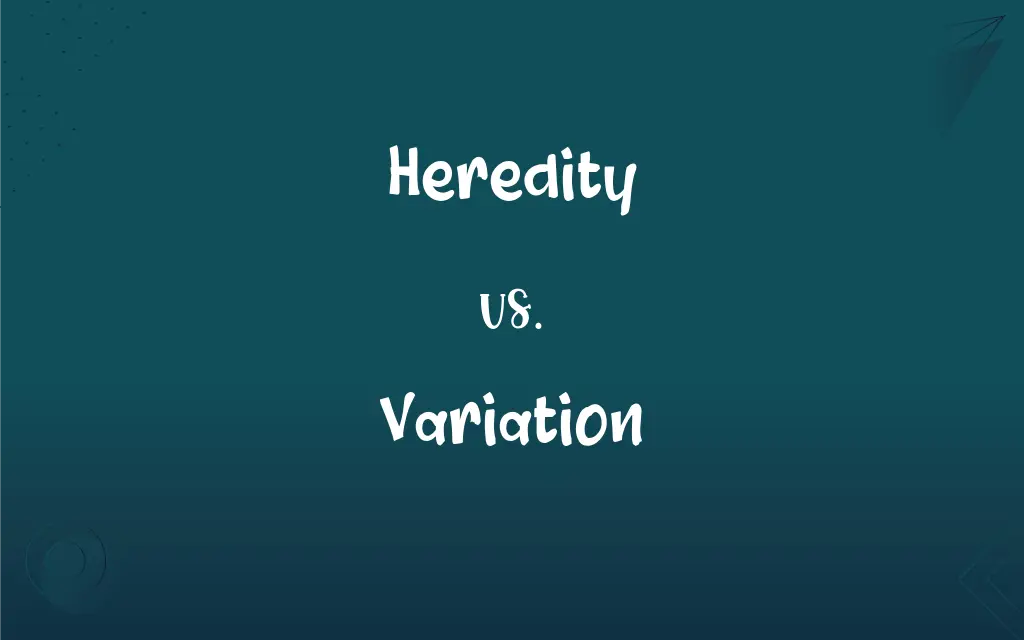Heredity vs. Variation: What's the Difference?
Edited by Aimie Carlson || By Harlon Moss || Updated on October 29, 2023
Heredity is the passing of traits from parents to offspring, while variation refers to the differences among individuals in a population.

Key Differences
Heredity is the process by which genetic information is passed from parents to offspring. Variation, on the other hand, refers to the differences among individuals within a population or species.
Heredity ensures that offspring resemble their parents and belong to the same species. Variation allows for diversity within a population, which can be beneficial for adaptation and survival.
Genes play a crucial role in heredity as they carry the information that determines traits. Variation can occur due to differences in genes or environmental factors.
Heredity follows the laws of Mendelian inheritance, while variation can result from genetic recombination, mutation, or environmental influences.
Both heredity and variation are key components of evolution, as they contribute to the genetic diversity of a population.
ADVERTISEMENT
Comparison Chart
Passing traits parent-offspring
Basis of transmission
Differences among individuals
Genes carry information
Role of genes
Genes and environment cause
Follows Mendelian laws
Inheritance patterns
Can result from mutation
Ensures offspring resemble parents
Contribution to species survival
Allows for diversity within population
Contributes to genetic diversity
Importance in evolution
Contributes to genetic diversity
ADVERTISEMENT
Heredity and Variation Definitions
Heredity
Heredity contributes to the genetic diversity of a population.
Heredity ensures the continuity of species characteristics.
Variation
Variation is a key component of evolution.
Evolution relies on variation to drive changes in populations over time.
Heredity
Heredity is the passing of genetic information from parents to offspring.
Heredity ensures that children resemble their parents.
Variation
Variation allows for diversity within a population.
Diversity increases the survival chances of a population.
Heredity
Heredity is a key component of evolution.
Evolution relies on heredity to pass traits through generations.
Variation
Variation refers to the differences among individuals in a population.
Variation is necessary for adaptation to different environments.
Heredity
Heredity follows Mendelian laws.
Mendelian laws explain how traits are inherited through heredity.
Variation
Variation can be caused by differences in genes or environmental factors.
Genetic variation results from mutation or recombination.
Heredity
Heredity is determined by genes.
Genes carry the information that defines heredity traits.
Variation
Variation contributes to the genetic diversity of a population.
Genetic diversity is important for the health of a population.
FAQs
What is heredity?
Heredity is the passing of genetic information from parents to offspring.
How does variation contribute to evolution?
Variation contributes to evolution by providing diversity within a population.
What is the role of genes in heredity?
Genes carry the information that determines the traits passed through heredity.
How does heredity contribute to evolution?
Heredity contributes to evolution by passing traits from one generation to the next.
What is variation?
Variation refers to the differences among individuals in a population.
What causes variation?
Variation can be caused by differences in genes or environmental factors.
What is genetic recombination?
Genetic recombination is the exchange of genetic material that contributes to variation.
How does evolution rely on variation?
Evolution relies on variation to drive changes in populations over time.
How are heredity and variation related?
Heredity and variation are related as they both contribute to the genetic diversity of a population.
How does variation affect adaptation?
Variation provides the diversity necessary for a population to adapt to different environments.
How does evolution rely on heredity?
Evolution relies on heredity to pass traits from one generation to the next.
What is the importance of diversity within a population?
Diversity is important as it increases the survival chances of a population in changing environments.
How is variation beneficial for a population?
Variation allows for diversity within a population, which can be beneficial for adaptation and survival.
What are Mendelian laws?
Mendelian laws explain how traits are inherited through heredity.
How is adaptation important for survival?
Adaptation is important for survival as it allows a population to thrive in different environments.
Is genetic diversity important for a population?
Yes, genetic diversity is important for the health and survival of a population.
How does mutation contribute to variation?
Mutation can create new genetic material that contributes to variation.
How does diversity contribute to the health of a population?
Diversity contributes to the health of a population by reducing the risks of genetic diseases and increasing adaptability.
How does heredity ensure offspring resemble their parents?
Heredity ensures offspring resemble their parents by passing down genetic information.
Can environmental factors cause variation?
Yes, environmental factors can cause variation among individuals in a population.
About Author
Written by
Harlon MossHarlon is a seasoned quality moderator and accomplished content writer for Difference Wiki. An alumnus of the prestigious University of California, he earned his degree in Computer Science. Leveraging his academic background, Harlon brings a meticulous and informed perspective to his work, ensuring content accuracy and excellence.
Edited by
Aimie CarlsonAimie Carlson, holding a master's degree in English literature, is a fervent English language enthusiast. She lends her writing talents to Difference Wiki, a prominent website that specializes in comparisons, offering readers insightful analyses that both captivate and inform.































































